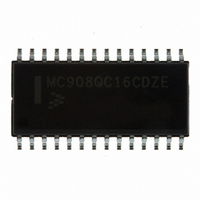MC908QC16CDZE Freescale Semiconductor, MC908QC16CDZE Datasheet - Page 42

MC908QC16CDZE
Manufacturer Part Number
MC908QC16CDZE
Description
IC MCU 8BIT 16K FLASH 28-SOIC
Manufacturer
Freescale Semiconductor
Series
HC08r
Specifications of MC908QC16CDZE
Core Processor
HC08
Core Size
8-Bit
Speed
8MHz
Connectivity
SCI, SPI
Peripherals
LVD, POR, PWM
Number Of I /o
24
Program Memory Size
16KB (16K x 8)
Program Memory Type
FLASH
Ram Size
512 x 8
Voltage - Supply (vcc/vdd)
3 V ~ 5.5 V
Data Converters
A/D 10x10b
Oscillator Type
Internal
Operating Temperature
-40°C ~ 85°C
Package / Case
28-SOIC (7.5mm Width)
Processor Series
HC08QC
Core
HC08
Data Bus Width
8 bit
Data Ram Size
512 B
Interface Type
ESCI/SPI
Maximum Clock Frequency
8 MHz
Number Of Programmable I/os
26
Number Of Timers
6
Maximum Operating Temperature
+ 85 C
Mounting Style
SMD/SMT
Development Tools By Supplier
FSICEBASE, M68CBL05AE, DEMO908QB8, DEMO908QC16
Minimum Operating Temperature
- 40 C
On-chip Adc
10-ch x 10-bit
For Use With
DEMO908QC16 - BOARD DEMO FOR MC908QC16
Lead Free Status / RoHS Status
Lead free / RoHS Compliant
Eeprom Size
-
Lead Free Status / Rohs Status
Lead free / RoHS Compliant
Available stocks
Company
Part Number
Manufacturer
Quantity
Price
Company:
Part Number:
MC908QC16CDZE
Manufacturer:
FREESCALE
Quantity:
1 600
Part Number:
MC908QC16CDZE
Manufacturer:
FREESCALE
Quantity:
20 000
- Current page: 42 of 274
- Download datasheet (4Mb)
Memory
2.6.7 EEPROM Memory Emulation Using FLASH Memory
In some applications, the user may want to repeatedly store and read a set of data from an area of
nonvolatile memory. This is easily implemented in EEPROM memory because single byte erase is
allowed in EEPROM.
When using FLASH memory, the minimum erase size is a page. However, the FLASH can be used as
EEPROM memory. This technique is called “EEPROM emulation”.
The basic concept of EEPROM emulation using FLASH is that a page is continuously programmed with
a new data set without erasing the previously programmed locations. Once the whole page is completely
programmed or the page does not have enough bytes to program a new data set, the user software
automatically erases the page and then programs a new data set in the erased page.
In EEPROM emulation when data is read from the page, the user software must find the latest data set
in the page since the previous data still remains in the same page. There are many ways to monitor the
page erase timing and the latest data set. One example is unprogrammed FLASH bytes are detected by
checking programmed bytes (non-$FF value) in a page. In this way, the end of the data set will contain
unprogrammed data ($FF value).
A couple of application notes, describing how to emulate EEPROM using FLASH, are available on our
web site. Titles and order numbers for these application notes are given at the end of this subsection.
42
FLASH BLOCK PROTECT
START ADDRESS OF
MC68HC908QC16 • MC68HC908QC8 • MC68HC908QC4 Data Sheet, Rev. 5
and so on...
1. The end address of the protected range is always $FFFF.
2. $BE00–$BFFF is always protected unless the entire FLASH memory is un-
$FD (1111 1101)
$FE (1111 1110)
$01 (0000 0001)
$02 (0000 0010)
$03 (0000 0011)
protected, BPR[7:0] = $FF.
BPR[7:0]
Table 2-2. Examples of Protect Start Address
$00
Figure 2-6. FLASH Block Protect Start Address
$FF
(2)
1
1
The entire FLASH memory is not protected.
The entire FLASH memory is protected.
Start of Address of Protect Range
16-BIT MEMORY ADDRESS
$C0C0 (1100 0000 1100 0000)
$C040 (1100 0000 0100 0000)
$C080 (1100 0000 1000 0000)
$FF40 (1111 1111 0100 0000)
$FF80 (1111 1111 1000 0000)
FLBPR VALUE
0
0
(1)
0
0
Freescale Semiconductor
0
0
Related parts for MC908QC16CDZE
Image
Part Number
Description
Manufacturer
Datasheet
Request
R
Part Number:
Description:
Manufacturer:
Freescale Semiconductor, Inc
Datasheet:
Part Number:
Description:
Manufacturer:
Freescale Semiconductor, Inc
Datasheet:
Part Number:
Description:
Manufacturer:
Freescale Semiconductor, Inc
Datasheet:
Part Number:
Description:
Manufacturer:
Freescale Semiconductor, Inc
Datasheet:
Part Number:
Description:
Manufacturer:
Freescale Semiconductor, Inc
Datasheet:
Part Number:
Description:
Manufacturer:
Freescale Semiconductor, Inc
Datasheet:
Part Number:
Description:
Manufacturer:
Freescale Semiconductor, Inc
Datasheet:
Part Number:
Description:
Manufacturer:
Freescale Semiconductor, Inc
Datasheet:
Part Number:
Description:
Manufacturer:
Freescale Semiconductor, Inc
Datasheet:
Part Number:
Description:
Manufacturer:
Freescale Semiconductor, Inc
Datasheet:
Part Number:
Description:
Manufacturer:
Freescale Semiconductor, Inc
Datasheet:
Part Number:
Description:
Manufacturer:
Freescale Semiconductor, Inc
Datasheet:
Part Number:
Description:
Manufacturer:
Freescale Semiconductor, Inc
Datasheet:
Part Number:
Description:
Manufacturer:
Freescale Semiconductor, Inc
Datasheet:
Part Number:
Description:
Manufacturer:
Freescale Semiconductor, Inc
Datasheet:











